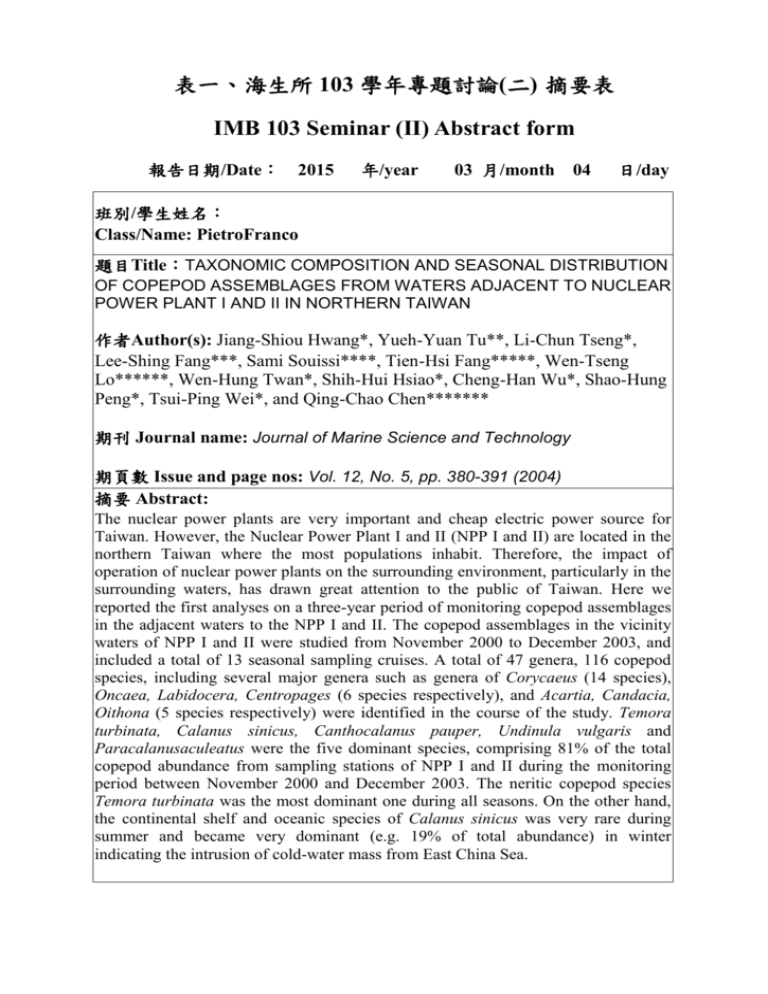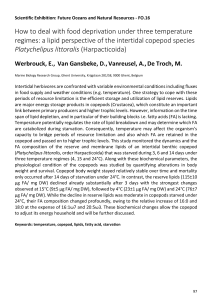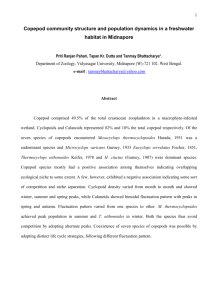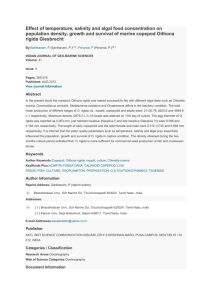海生所103學年專題討論(二) 摘要表 IMB 103 Seminar (II) Abstract
advertisement

表一、海生所 103 學年專題討論(二) 摘要表 IMB 103 Seminar (II) Abstract form 報告日期/Date: 2015 年/year 03 月/month 04 日/day 班別/學生姓名: Class/Name: PietroFranco 題目Title:TAXONOMIC COMPOSITION AND SEASONAL DISTRIBUTION OF COPEPOD ASSEMBLAGES FROM WATERS ADJACENT TO NUCLEAR POWER PLANT I AND II IN NORTHERN TAIWAN 作者Author(s): Jiang-Shiou Hwang*, Yueh-Yuan Tu**, Li-Chun Tseng*, Lee-Shing Fang***, Sami Souissi****, Tien-Hsi Fang*****, Wen-Tseng Lo******, Wen-Hung Twan*, Shih-Hui Hsiao*, Cheng-Han Wu*, Shao-Hung Peng*, Tsui-Ping Wei*, and Qing-Chao Chen******* 期刊 Journal name: Journal of Marine Science and Technology 期頁數 Issue and page nos: Vol. 12, No. 5, pp. 380-391 (2004) 摘要 Abstract: The nuclear power plants are very important and cheap electric power source for Taiwan. However, the Nuclear Power Plant I and II (NPP I and II) are located in the northern Taiwan where the most populations inhabit. Therefore, the impact of operation of nuclear power plants on the surrounding environment, particularly in the surrounding waters, has drawn great attention to the public of Taiwan. Here we reported the first analyses on a three-year period of monitoring copepod assemblages in the adjacent waters to the NPP I and II. The copepod assemblages in the vicinity waters of NPP I and II were studied from November 2000 to December 2003, and included a total of 13 seasonal sampling cruises. A total of 47 genera, 116 copepod species, including several major genera such as genera of Corycaeus (14 species), Oncaea, Labidocera, Centropages (6 species respectively), and Acartia, Candacia, Oithona (5 species respectively) were identified in the course of the study. Temora turbinata, Calanus sinicus, Canthocalanus pauper, Undinula vulgaris and Paracalanusaculeatus were the five dominant species, comprising 81% of the total copepod abundance from sampling stations of NPP I and II during the monitoring period between November 2000 and December 2003. The neritic copepod species Temora turbinata was the most dominant one during all seasons. On the other hand, the continental shelf and oceanic species of Calanus sinicus was very rare during summer and became very dominant (e.g. 19% of total abundance) in winter indicating the intrusion of cold-water mass from East China Sea.











